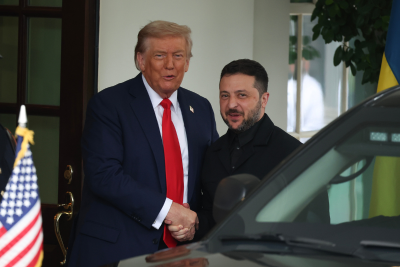Europe has allocated more money in direct, bilateral aid to Ukraine than the U.S. has during the war with Russia. But in President Donald Trump’s remarks surrounding recent meetings with the leaders of Russia and Ukraine, he falsely claimed that the U.S. has given Ukraine more than three times as much as Europe.
In an Aug. 15 interview with Fox News’ Sean Hannity after the president’s meeting in Alaska with Russian President Vladimir Putin, Trump, as he has before, provided an inaccurate comparison of U.S. and European aid to Ukraine. “You know, we gave them $350 billion. Europe gave them much less, but still a lot. A hundred billion dollars,” Trump said.

Trump repeated those figures in an Aug. 19 interview on “Fox & Friends” the day after he met with Ukrainian President Volodymyr Zelenskyy and European leaders in the White House. “We’ve spent through the previous administration $350 billion. Europe has spent a lot also, 100 billion, but it should be reversed, if we should have been in for anything,” he said.
His claim is incorrect. An August report from the special inspector general overseeing U.S. support for Ukraine said more than $187 billion was made available through June for military operations and the broader response to Russia’s invasion since February 2022. As we’ve written, about $174.2 billion of that was approved in five bipartisan appropriation bills, according to the Congressional Research Service. In addition, the U.S. provided to Ukraine a $20 billion loan to be repaid with proceeds from frozen Russian assets.
As for Europe, it had allocated 167.4 billion euros (equal to about $195 billion today) in aid to Ukraine as of June 30, according to the Kiel Institute for the World Economy, a German research group that publishes the Ukraine Support Tracker. For a direct comparison, the Kiel Institute said that is more than the 114.6 billion euros (or about $133 billion) in aid allocated by the U.S in that period. The Kiel Institute’s totals include only direct, bilateral (government-to-government) military, financial and humanitarian aid allocations to Ukraine. That’s why the U.S. total is less than what was appropriated by Congress, since a portion of that money was spent in the U.S. rather than in Ukraine.
Europe also has committed an additional 90 billion euros for Ukraine aid not yet allocated, the Kiel Institute says, while the U.S. has committed another 4.4 billion euros.
What’s Behind Trump’s U.S. Figure?
In an Aug. 18 Oval Office meeting with Zelenskyy, Trump again brought up U.S. aid to Ukraine during the Biden administration, saying, “I believe the number is over 300 [billion dollars], I think it could be $350 billion worth of equipment and money and everything else.”
A White House official told us in an email that Trump’s figure includes the direct U.S. spending as a result of the war as well as indirect economic costs calculated by the White House, including more than $93 billion in inflation caused by the war, over $16 billion in lost trade revenue due to sanctions on Russia, and about $7 billion from higher prices for fertilizer. (No indirect cost calculation was provided for Europe.)
Mark F. Cancian, senior adviser in the defense and security department at the Center for Strategic & International Studies, told us in an email that the White House total “looks like it was thrown together.”
Cancian said the loss of revenue from sanctions “is plausible,” though he said he would leave it to economists to determine how to calculate the amount. “The rest is laughable,” he said.
He noted that the White House attributed all of the inflation from 2021 to 2023 to Russia’s war with Ukraine, but none to domestic U.S. policies. (The White House’s figure comes from multiplying a 2023 estimate for the impact of inflation on families by the number of households in the U.S.) We’ve also written that the COVID-19 pandemic and its effects were the root causes of high inflation during that period.
It’s notable that the White House blames Russia’s war, which indeed contributed to higher inflation as the U.S. and other countries put sanctions on Russian oil. But during the campaign, Trump repeatedly blamed the Biden administration and “what they did with energy,” and in his inaugural address, he said inflation “was caused by massive overspending and escalating energy prices.”
Cancian directed us to the figures produced by the Kiel Institute, which he said “does a global analysis using a consistent methodology, so it is good for comparing national contributions.” Those figures show Europe giving more directly to Ukraine than the U.S.
Editor’s note: FactCheck.org does not accept advertising. We rely on grants and individual donations from people like you. Please consider a donation. Credit card donations may be made through our “Donate” page. If you prefer to give by check, send to: FactCheck.org, Annenberg Public Policy Center, P.O. Box 58100, Philadelphia, PA 19102.